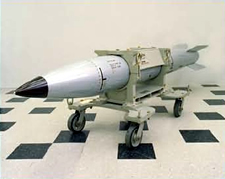Publication: US Nuclear Weapons in Europe

The US Air Force deploys 150-200 B61 nuclear bombs in Europe.
Following NATO’s strategic concept and expectations that the next round of US-Russian nuclear arms control negotiations will deal with tactical nuclear weapons in some shape or form, Stan Norris and I have published our latest estimate on U.S. nuclear weapons in Europe in the Bulletin of the Atomic Scientists.
Although the strategic concept states that “any” further reductions “must take into account the disparity with the greater Russian stockpiles of short-range nuclear weapons,” NATO has in fact been willing to make significant unilateral reductions in this decade regardless of disparity. Likewise, the United States has scrapped most of its tactical nuclear weapons because they are no longer important. It is important that the disparity argument does not become an excuse to prevent further reductions.
Our estimate of Russian tactical nuclear weapons is here with more details here.
Later this spring we will publish a more comprehensive report on U.S. and Russian tactical nuclear weapons.
This publication was made possible by a grant from Carnegie Corporation of New York and Ploughshares Fund. The statements made and views expressed are solely the responsibility of the author.
While it is reasonable for governments to keep the most sensitive aspects of nuclear policies secret, the rights of their citizens to have access to general knowledge about these issues is equally valid so they may know about the consequences to themselves and their country.
Nearly one year after the Pentagon certified the Sentinel intercontinental ballistic missile program to continue after it incurred critical cost and schedule overruns, the new nuclear missile could once again be in trouble.
“The era of reductions in the number of nuclear weapons in the world, which had lasted since the end of the cold war, is coming to an end”
Without information, without factual information, you can’t act. You can’t relate to the world you live in. And so it’s super important for us to be able to monitor what’s happening around the world, analyze the material, and translate it into something that different audiences can understand.